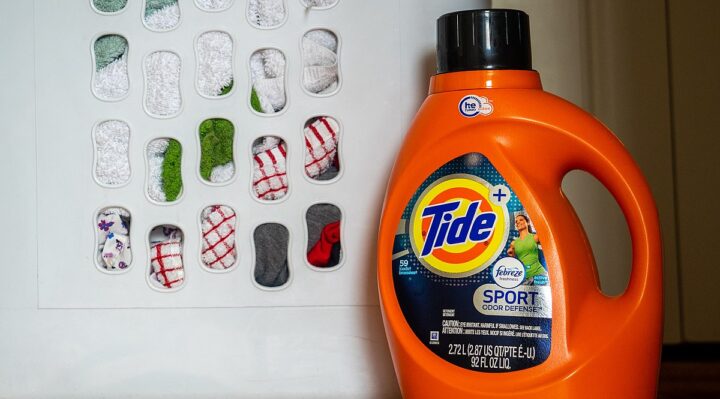If you’re wondering how to wash with detergent, you’re not alone. This comprehensive guide will take you through each step to ensure a thorough and effective cleaning process.

Table of Contents
Things You’ll Need
To follow this guide on how to wash with detergent, you’ll need the following materials:
Preparation
Before touching that laundry basket, pause to read the care labels meticulously on each garment you intend to wash. These small but essential tags often carry crucial information, including washing temperature, drying requirements, and whether a garment can be ironed.
Symbols are the language of care labels, so if you come across an icon you don’t recognize, take a moment to look it up online or consult your machine’s manual.
Double-check to make sure all your clothes are suitable for machine washing with detergent. This initial precaution can save you from accidentally damaging sensitive items in the wash.
Sorting the Laundry
The adage ‘well begun is half done’ rings true when it comes to laundry. Proper sorting is the foundation of a successful wash. Group your clothes into piles of whites, darks, and colors to prevent color transference during washing. Go a step further by also categorizing by fabric type.
Delicate items like lace, silk, and wool should be separated from more resilient fabrics such as cotton and polyester. During this sorting phase, take some additional time to inspect pockets for stray objects like coins, keys, or tissues, as these can lead to laundry disasters like staining or machine damage.
Adding Detergent
When it’s time to add detergent, measuring accurately is essential. Use a measuring cup and follow the manufacturer’s guidelines on the detergent packaging to determine the right amount.
An inadequate amount of detergent can leave your clothes less than clean, while excess detergent can result in residue on your garments and even contribute to environmental waste. In modern washing machines, you’ll often find designated compartments for detergent.
These might be labeled for specific wash cycles like ‘pre-wash’ or ‘main wash,’ so be attentive and add the detergent to the appropriate compartment based on your chosen cycle.
Loading the Washing Machine
Now, it’s time to load your washing machine, and how you do it matters. An overloaded machine compromises the effectiveness of the wash, leaving you with less-than-clean clothes. On the other hand, an underloaded machine wastes water and energy.
A good practice is to load the drum until it’s about three-quarters full. Ensure that you distribute the clothes evenly around the drum to maintain balance during the wash cycle. Untangle any twisted sleeves or pant legs, as tangled clothes can result in uneven washing and wrinkling.
Washing
Navigating the settings on your washing machine might seem daunting, but it’s simpler than it looks. Most machines offer a variety of cycles ranging from ‘Delicates’ to ‘Heavy Duty.’ Choose a cycle that aligns with the garments you are washing.
Delicate fabrics like silk or lace typically require a ‘Gentle’ or ‘Delicate’ cycle, whereas everyday fabrics like cotton and polyester can handle ‘Regular’ or ‘Normal’ cycles. Use the dial or digital interface to select your desired cycle.
Once that’s done, start the machine and let it complete the entire cycle. Interrupting the cycle should be a last resort, as it can compromise the wash quality and may even require you to restart the cycle.
Unloading
The completion of the wash cycle signals that it’s time to unload your washing machine, and doing so promptly has its own set of benefits.
Letting laundry sit in the drum even for a short period can lead to unpleasant, musty odors emanating from the fabric. In more severe cases, it can even lead to mildew. Additionally, certain fabrics are more prone to wrinkling if left sitting wet in the machine.
As you begin to unload, handle each garment individually. Gently shake it to loosen any folds and help minimize wrinkles. This simple action can make a noticeable difference, especially for items that are prone to wrinkling like cotton shirts or linen pants.
Once you’ve shaken out each garment, it’s important to fold or hang them right away. Delaying this can lead to additional wrinkling, which could necessitate ironing later on.
If you have the time and space, it’s highly advisable to hang items like dress shirts, trousers, and dresses. For garments like t-shirts, pajamas, and socks, folding them neatly will suffice.
For more articles on how to wash, click here: How to Wash: Your Comprehensive Guide to Clothing and Fashion Care
Conclusion: How to Wash With Detergent
Successfully washing your clothes with detergent involves more than just tossing garments into a machine and pushing a button.
As we’ve outlined, each step—from reading care labels to proper sorting, precise detergent measurement, strategic machine loading, and informed cycle selection—plays a crucial role in ensuring a clean, fresh, and damage-free laundry experience.
Taking the time to execute each of these steps carefully will not only result in cleaner clothes but will also extend the lifespan of your garments and your washing machine. So the next time you find yourself facing a pile of dirty laundry, remember that a systematic, thoughtful approach is your best ally in achieving laundry success.
